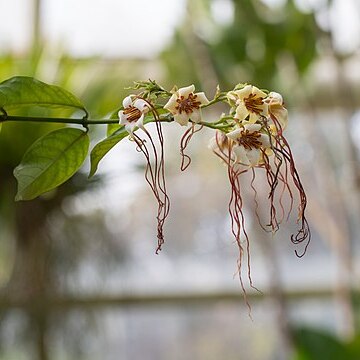Shrubs, sarmentose shrubs, or lianas, rarely trees (but not in our area); latex present in most parts; bark rough, sometimes with corky protuberances, lenticellate; stipules reduced to small rims. Leaves opposite or ternate, rarely quaternate, with colleters in the axil of the petiole. Inflorescence terminal or in forks of branches, rarely axillary, 1–many-flowered in simple or compound dichasial cymes; bracts sepal-like or scarious. Flowers 5-merous. Calyx imbricate-quincuncial, deciduous in fruit, colleters present adaxially. Corolla often with long tails to the lobes, the tube cylindrical proximally and slightly wider distally becoming infundibuliform, at the mouth with a 10-lobed corona, the lobes erect and in pairs at the margins of the corolla lobes, lobes alternisepalous, overlapping to the right, ovate to oblong, at the apex acute to tailed. Stamens included or partly exserted, connate to the style and forming a cone around the distal part of the style and stigma. Ovary 2–celled, the cells partly connate, style terete, stigma subtended by an angular clavuncula. Fruit of 2 woody mericarps on a thickened woody pedicel, the mericarps usually divergent. Seeds many per mericarp, narrowly ovoid with a beaked apical coma.
Lianas or erect or stolon-bearing shrubs, rarely trees, with latex. Leaves opposite or in whorls of 3. Cymes mostly dichasial, terminal, pedunculate or sessile. Flowers large. Sepals free or connate at base, imbricate or quincuncial, basal glands 5 to many. Corolla funnelform, usually turning darker and dark streaked at anthesis; tube short, throat wide; lobes overlapping and mostly twisted to right, distal portions mostly forming filiform, involute long tails; corona 10-lobed, inserted at base of corolla lobes. Stamens inserted at apex of corolla tube; filaments short; anthers sagittate, connivent, adherent to pistil head, spurred at base; disc absent. Ovaries 2, ± connate at base; ovules numerous in each locule. Style filiform. Follicles 2, divaricate. Seeds numerous, with beaked apical coma.
Corolla consisting of tube, corona, and lobes; colour scheme based on contrasting white and red, later turning yellow and purple; tube widening at the level where the anthers are inserted; corona 10-lobed with the lobes arranged in partly connate pairs at the basal margins of the lobes; lobes often produced into long, linear tails overlapping to the right, in open flowers spreading or recurved, basal part of lobe ovate.
Inflorescence terminal (often on short lateral branches) or in the forks of branches, one to many-flowered in cymes; bracts sepal-like or smaller in size, in the axil with colleters.
Seeds rostrate, with a rostrate apical coma; grain almost fusiform; rostrum often partly glabrous; endosperm in a thin layer completely surrounding the spathulate, straight embryo.
Ovary 2-celled, semi-inferior or rarely superior, ovoid, with many ovules; style slender, glabrous; clavuncula with a basal frill and an apical crown surrounding the small stigma.
Leaves decussate or ternate, rarely quaternate, those of a pair or a whorl equal or subequal, with 2–20 colleters in the leaf axil; lamina ovate, elliptic or obovate.
Stamens included or partly exserted, anthers connivent in a cone around the apex of the style, auriculate at the base, mucronate or acuminate at the apex.
Fruit of 2 divergent, rigid, woody or thin-woody follicles, many-or rarely few-seeded, tapering to their apex and ending in a narrow point or a knob.
Trunk dichotomously or trichotomously branched or with single or opposite lateral branches, unarmed, lenticellate.
Sepals imbricate, free to the base, at the base inside with colleters.
Flowers actinomorphic or with only the sepals unequal.
Lianas or sarmentose shrubs; latex present.
Disk absent.

